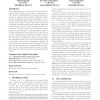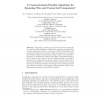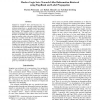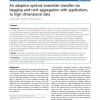458 search results - page 23 / 92 » Listwise approach to learning to rank: theory and algorithm |
TSP
2008
13 years 9 months ago
2008
The focus of this paper is on VLIW instruction scheduling that minimizes the variation of power consumed by the processor during the execution of a target program. We use rough set...
KDD
2006
ACM
14 years 9 months ago
2006
ACM
Several algorithms have been proposed to learn to rank entities modeled as feature vectors, based on relevance feedback. However, these algorithms do not model network connections...
EUROPAR
2004
Springer
14 years 2 months ago
2004
Springer
Computing a spanning tree and the connected components of a graph are basic problems in Graph Theory and arise as subproblems in many applications. Dehne et al. present a BSP/CGM a...
AAAI
2011
12 years 9 months ago
2011
Inspired by “GoogleTM Sets” and Bayesian sets, we consider the problem of retrieving complex objects and relations among them, i.e., ground atoms from a logical concept, given...
BMCBI
2010
13 years 9 months ago
2010
Background: Generally speaking, different classifiers tend to work well for certain types of data and conversely, it is usually not known a priori which algorithm will be optimal ...




